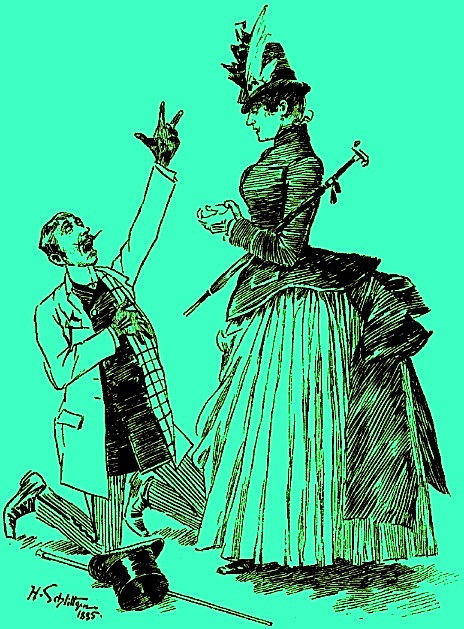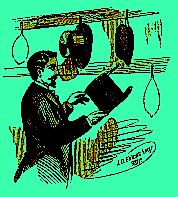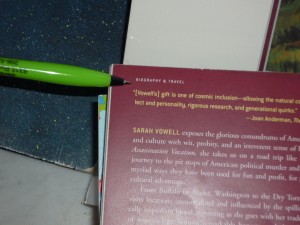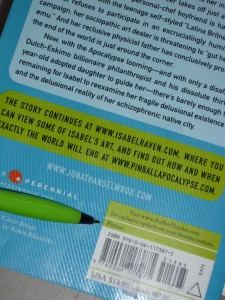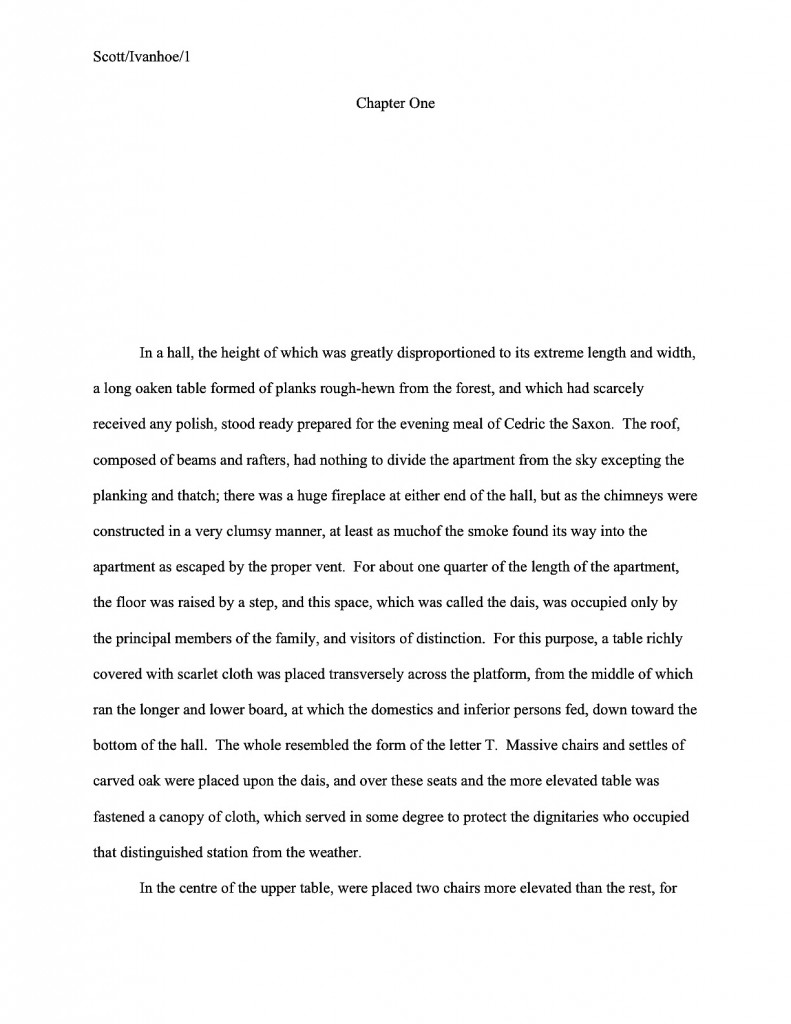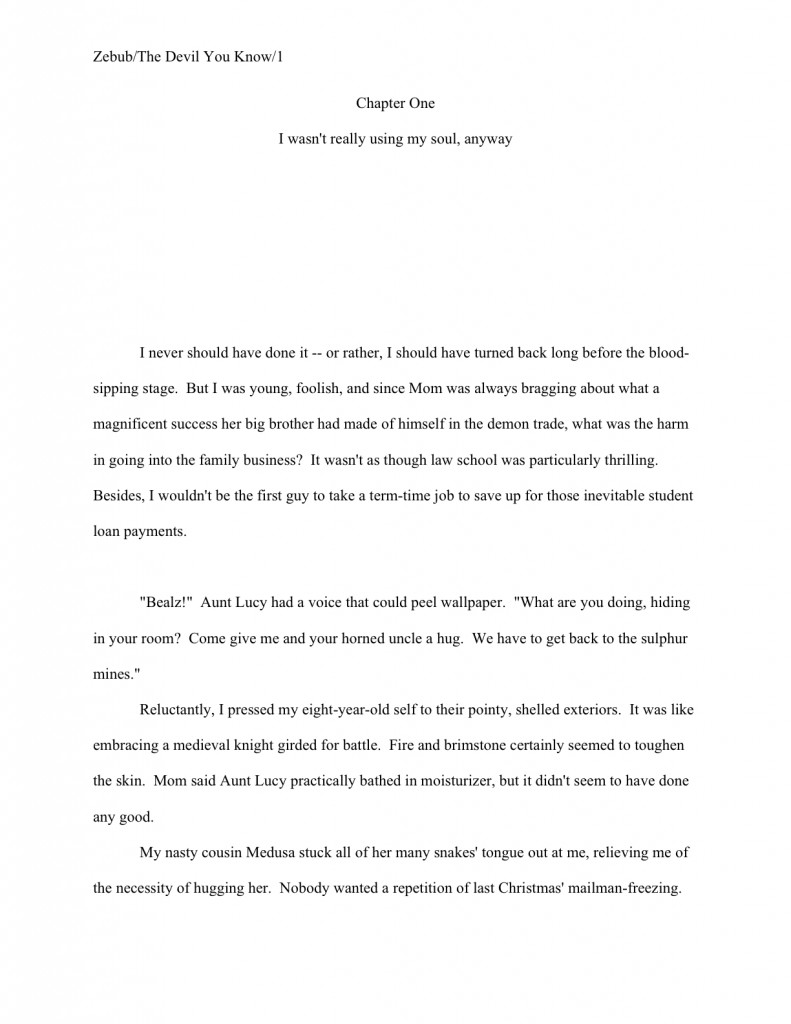
Sorry about the several-day silence, campers. Apparently, there are two strains of flu going around this winter; both were kind enough to stop by my house. I’m going to keep it short today, so I can get right back to such intellectually stimulating endeavors as forcing liquids and lying helplessly under a cat.
I didn’t want to leave you hanging so close to the end of this long series on how books do — and don’t — currently get published in the US market. It’s been quite a journey, hasn’t it? We debunked a few common myths about getting published (most notably, the one about good writing always finding an agent or publisher relatively quickly), approaching major publishing houses (if the houses you have in mind are located within the United States, you need an agent to do it for you), how agents handle queries and submissions from aspiring writers, and finally, what happens to a manuscript after an agent picks it up.
Did you find all that empowering, or just depressing? The former, I hope: once a writer can recognize that the formal hurdles she’s expected to jump to land an agent and/or find a publisher for her manuscript are just that, formal hurdles designed to discourage writers who haven’t done their homework, rather than a series of referenda on how talented she is, she can plan accordingly.
How so? Well, if a query, submission, or book proposal does not follow the rules, it tends not to matter how good the writing in the manuscript is. Contrary to popular opinion amongst aspiring writers, professionalism is almost as important as talent, at least in the initial approach.
Or, to put it less delicately, not taking the time to learn the ropes only seems as if it would speed up the trip from completed manuscript to publication. In reality, just leaping into querying or submission unprepared usually lengthens that trip.
Yes, yes, I know: those of you who have been querying or submitting for a nice, long while are shocked, shocked, to hear that the learning curve for those new to the trying-to-get-published game can be pretty steep. But remember, this honestly was news to every currently-published writer at some point.
Hey, it’s complicated stuff.
Thus this series. I habitually devote a great deal of blog space to showing aspiring writers a few short cuts, but once a year, I like to place that advice within a larger context. And frankly, every year, I take a lot of flak from the pros for doing it. Seriously.
Why, you ask? Well, every pro has a slightly different reason, but the one I (and others devoted to helping aspiring writers over the technical hurdles) hear the most tends to run a little something like this: blogs like yours have made it harder to tell the good manuscripts from the rest. Back before it was so easy for writers to find out what to do, far more queries were instantly rejectable; before you started yammering about standard format, most submissions could be dismissed at a glance.
I take this as a compliment — because why, really, should a writer brand-new to the game know how these things are done? Given how complex, counter-intuitive, and let’s face it, contrary to the prevailing societal notions of how books get published the realities are, it’s just a bit puzzling that folks in the publishing industry just expect serious aspiring writers to pick up the basics on their own. It’s not as though rejections typically include admonitions to learn how to write a professional query letter, for instance, or come right out and say, “Look, we read only the first paragraph of your submission because it was not double-spaced, contained three typos and a cliché in the opening sentence, and was printed on off-white paper instead of bright white. That’s no reflection on your writing style — but if you want to have a better shot next time, learn a little something about what we expect to see.”
What do rejected writers see instead? We’re sorry, but this manuscript does not fit our needs at this time. Or I just didn’t fall in love with this story.
“But what does that mean?” aspiring writers constantly ask me in despair. “I know that this agent is telling me something about how I can improve my query/submission, but I can’t figure out what!”
Actually, the agent probably isn’t: most rejections are form-letter boilerplate, and thus not personalized at all. The whole point of a form rejection is to minimize the time Millicent the agency screener has to devote to a query or submission her agency isn’t going to pick up, right? So unless a rejecter gives a specific reason, it’s just a waste of an aspiring writer’s energy to try to read anything into prepackaged phrases that are equally likely to be applied to a poorly-written query that Millie never even considered and a professional-sounding one that just didn’t read as though her boss agent would be interested in the story.
Except to consider the possibility that Millicent is implicitly saying, look, I can’t take your work seriously until you learn the ropes.
Notice how often the word serious has cropped up in the last few paragraphs? There’s a reason for that: in the publishing world, a serious writer is by definition someone who not only has talent and good ideas for books, but has taken the time to learn how to present her work professionally.
That made some of you roll your eyes, didn’t it?
I’m not too surprised. Throughout this series, I’ve been sensing a strange combination of discomfort, disbelief, and outright outrage floating around in that part of the cosmic ether where I choose to imagine my far-flung readership resides. Oh, the discontented have been too nice to kick up much of a protest over my account of these rather grim realities, but since the commenter-to-non-commenting-reader ratio on any blog is quite top-heavy, I’ve gotten good at sensing unspoken confusion. If I had to guess the single sentiment that has been muttered most often by readers of this series, it would be this:
“Hey — that’s not what I heard!”
Hands up, everyone who has thought some permutation of this sentiment, either earlier in this series or when getting the skinny from some ostensibly authoritative source like me. In a way, I applaud this reaction — since there’s such a lot of advice out there for writers, you should be thinking critically about all of the marketing and writing advice you hear. If I haven’t mentioned recently, it’s not a good idea to take any self-described publishing expert as gospel, even if that expert happens to be yours truly.
That can be an awfully tall order; as most of you are probably already aware, there are a LOT of conflicting prescriptions for writing success floating around. Including, incidentally, the information writers pick up at literary conferences. On the conference dais and even during pitch sessions, aspiring writers sometimes hear radically mixed messages.
Don’t believe me? Okay, see if any of these scenarios sound at all familiar:
* A writer preparing to attend a conference diligently wades through both the standard agents’ guides and the websites of the agents scheduled to attend the conference. Once she hears those agents speak at the conference, she finds head spinning at how different her dream agent’s speech about what she wanted to represent right now was from her stated preferences in the guide or on her website.
* After waxing poetic behind a podium about how much he loves literature in general and his favorite genre in particular, an agent or editor brushes off those aspiring writers brave enough to take him at his word and approach him to pitch, giving cold responses ranging from “I don’t handle that sort of book” (spoken in a tone that implied that you should already have known that, whether or not he specified during his speech) to “Gee, that sounds interesting, but my client roster is totally full at the moment” (so why come to a conference to solicit more?)
* The agents at a particular conference say that they are eager to find new clients, yet none of them actually end up signing anyone who pitches to them there. (A more common occurrence than most of us who teach at conferences tend to admit.)
* An agent’s (or editor’s) warm face-to-face response to a writer’s conference pitch is very much at odds with her rather tepid and slow communications during the submission process. “But she loved my idea at the conference!” the writer will protest, tears in her eyes, wondering what she has done wrong. (The probable answer: nothing. The fact is, sometimes a nice conversation at a conference is just a nice conversation at a conference.)
Why am I bringing up these mixed messages here, toward the end of this series on the basic trajectory of publication, other than to validate some writers’ well-justified confusion?
Well, remember how I mentioned that the long, long road to publication tends to be quite a bit easier for a writer who has realistic expectations than one who does not? Expecting to hear at least partially conflicting advice from the pros will at least relieve a writer of the substantial stress of suspecting that there’s a secret handshake required to break into print, a trick that may be learned by following every single piece of advice one hears to the letter.
Trust me, that way lies madness. Do your homework, figure out what you’re going to do, and do it. Listen to new input, certainly, but use your acquired knowledge of how the industry does and doesn’t work to weigh how likely any fresh piece of advice is to help you.
I’m also bringing it up to encourage all of you to use caution in evaluating whether to pay to attend writers’ shindigs in the upcoming spring and summer conference seasons. Many conferences promote their conferences by implying, if not outright stating, that they’re flying in agents and editors who will sign attendees on the spot.
However, that’s seldom the case: many agents pick up only one or two clients a year out of ALL of the conferences they attend. And that’s in a year when the economy isn’t bottomed out and the publishing industry isn’t trying to figure out the whole e-book phenomenon.
I tremble to mention this, but there is even an ilk who goes to conferences simply to try to raise authorial awareness of market standards, with no intention of signing any authors. They attend simply to educate, as if their names on a conference brochure didn’t at least imply otherwise. Then there are the ones who attend conferences just so they can visit their girlfriends in cities far from New York, or who just want a tax-deductible vacation in the San Juans, and couldn’t be less interested in the writers’ conference whose dais they will be gracing.
Those last few are beyond the scope of my discussion here, but I’m sure the karmic record-keepers frown upon them from afar.
The good news is that doing your homework about any conference you are considering attending can help you avoid wasting your time pitching to people who aren’t interested in helping you get your work published. For some tips on figuring out how to maximize your chances of ending up at a conference where you will be able to pitch to — or at least hear useful, up-to-the-minute advice from — agents who are genuinely looking to represent books like yours, please see the posts under the CONFERENCE SELECTION category on the list at right.
Nor are mixed messages limited to conferences — there’s plenty of confusing information out there, posing as authoritative behind-the-scenes skinny. See if this one rings a bell:
An agency states categorically in one of the standard agency guides and/or on its website that it is looking for new authors in a wide array of genres, a list that apparently doesn’t change from year to year? Yet when a writer queries with a book in one of the listed categories, he is crushed by a form letter huffily announcing that the agency NEVER represents that kind of work.
I have personal experience with this one, I’m sorry to report. I once made the mistake of signing with an agent (who shall remain nameless, because I’m nicer than she) who listed herself as representing everything from literary fiction to how-to books, but who in fact concentrated almost exclusively on romance novels and self-help books, two huge markets. I did not learn until the end of our rather tumultuous association that she had signed me not because she admired the novel she was ostensibly pushing for me, but because I had a Ph.D.: she hoped, she told me belatedly, that I would become frustrated at the delays of the literary market and write a self-help book instead.
I know; I was pretty flabbergasted, too.
Why would an agent advertise that he is looking for book categories she does not intend to represent? Well, for the same reason that some agents and most editors go to conferences in the first place: just in case the next bestseller is lurking behind the next anxious authorial face or submission envelope.
No fooling: an agent may well represent cookbooks almost exclusively, but if the next DA VINCI CODE falls into his lap, he probably won’t turn it down. He may well reject 99.98% of the submissions in a particular genre (and actually state in his form rejections that he doesn’t represent the genre at all, as an easy out), but in his heart of hearts, he’s hoping lighting will strike.
A broad advertiser is always a gambler, at some level.
And yes, now that you mention it, that vagueness is very, very annoying for the writers who believed his blurb in a conference guide or website. (For some tips on how to decipher these, please see the HOW TO READ AN AGENCY LISTING category on the list at right.)
The fact is, not everything in this process is what it appears to be at first glance. Had I mentioned yet that those who do their homework tend to have an easier time?
The problem is, the very difficulty of the endeavor discourages many aspiring writers from approaching publishing as a business with ropes to learn. Fearful, they become downright superstitious: because the process can seem mean or even arbitrary to those who are new to it, it can be very tempting to cling to every new piece of information one hears.
I’m not going to lie to you: giving advice to would-be authors is big business these days. Just because a writer pays anywhere from fifty to several hundred dollars to attend a conference or intensive seminar doesn’t necessarily mean that what he will hear there is a single coherent explanation of what to do in order to get his book published.
Don’t expect it. Good seminars and conferences can be extremely informative — as long as you keep your critical faculties active at all times, because you are most assuredly going to be receiving some conflicting information.
Or at least information that might sound contradictory to a writer unfamiliar with the process. Allow me to explain.
The fine folks on the business side of publishing and those of us on the creative side of the business often speak rather different languages. If you’ve learned anything throughout this series, I hope that it was that necessarily, a writer thinks about her writing quite differently than an agent or editor does, and for the best possible reasons: for the writer, it’s self-expression; for the agent or editor, it’s a commodity to be sold.
The result: rampant communication problems between the two sides.
I wish I could refer you to a reliable, comprehensive translation guide between writer-speak and industry-speak, but frankly, I don’t know of one. Like other norms of publishing, a professional writer just sort of picks ‘em up by osmosis.
However, over the years I have gathered an accepted array of truisms that agents and editors tend to spout at eager authors they meet at conferences, in agents’ guides, and on their websites. Although aspiring writers often decide in retrospect that these statements were, at best, inaccurate and/or misleading, these are not lies so much as polite exit lines from conversations, statements of belief, and as often as not, sincere attempts to make struggling aspiring writers feel better about facing the genuinely daunting task of finding representation.
Yet from the writer’s point of view, they might as well be real whoppers.
So here’s my top ten list of confusing statements agents and editors tend to make at conferences — and, increasingly, in form-letter rejections. Because I love you people, I have also included a translation for each in writer-speak, as well as a prescription for reacting to it.
Do keep this guide by you the next time you receive a rejection letter or go to a conference, so you can keep score — and your sanity.
10. “There just isn’t a market for this kind of book right now.”
Translation: I don’t want to represent/buy it, for reasons that may well have something to do with what is selling at the moment, but may also relate to my not having the connections to sell this particular kind of book at this juncture.
Prescription: don’t waste both your time and his by approaching him with books in categories he hasn’t sold recently; move on.
9. “The market’s never been better for writers.”
Translation: I have a very strong preference for representing previously published authors. Since it is now possible for any aspiring writer to self-publish a blog or write for a website, I don’t think there’s any excuse for a really talented writer not to have a relatively full writing resume. (Note: this attitude is almost never seen in those who have ever written anything themselves.)
Prescription: approach someone who says this only after you have a few solid writing credentials gracing your query letter.
8. “I could have sold this 10/20/2 years ago, but now…”
Translation: You’re a good writer (or your pitch was good), but I’m looking for something that more closely resembles the most recent bestseller. I’m not even vaguely interested in anything else right now. Actually, I am pretty miffed at you authors for not paying closer attention to the bestseller lists, because, frankly, you’re wasting my time.
OR:
You’re a good writer, but I started being an agent/editor a long time ago, back when it was easier to sell books. Your work may have a political slant that has gone out of fashion, or it is too long, or it shares some other trait with a book I truly loved that I struggled to sell for a year to no avail. I don’t want to get my heart broken again, so I really wish you would write something else. Have you checked the bestseller list lately?
OR:
The literary market is changing rapidly right now, and so are my connections. So while I may have a respectable track record in selling books just like yours, I’m not certain that I can do it now.
Prescription: assume this one isn’t taking on new clients right now and move on.
7. “We gave your work careful consideration.”
Translation: like most submissions, we probably invested less than a minute in reading it — and by we, I really mean an underpaid intern who was looking for predetermined grabbers on the first page or in the query letter. Please do not revise and resubmit, because we’re really, really busy.
OR:
If I had actually taken the time to read it, I might have had some constructive comments to make, but I simply haven’t the time. In my heart of hearts, I do feel rather guilty for not having done so; that is why I am making this defensive statement in my form-letter reply.
OR:
Your manuscript made it past the screening eyes of three Millicents, and I stuck within it for the first 20 pages before I got distracted. But I just don’t think that I can sell this right now.
Prescription: no means no, no matter how it is phrased. Unless the rejection includes some feedback overtly applicable to your book, assume that this is a form letter and move on.
6. “The length of the manuscript doesn’t matter, if the writing quality is high.”
Translation: I don’t want to be the one to tell you this, but a first novel shouldn’t be more than 400 pages for literary or mainstream fiction, 250-350 for anything else. (Anne here, breaking in mid-translation: for the benefit of those of you who just turned pale, you’ll find an explanation under the BOOK LENGTH category at right. Also, these page counts assume standard manuscript format — and if you don’t know what that is, please see the HOW TO FORMAT A MANUSCRIPT category.)
OR:
Frankly, I think you should have taken the time to check how long works in your genre are. However, if you’re a spectacularly talented writer, I would like a peek at your work, because maybe I could work with you to bring it under accepted limits.
OR:
I think the current length standards are really stupid, and I don’t want to give them more credibility by stating them here.
Prescription: walk into a well-stocked bookstore and flip though ten or twelve recently-published books similar to yours. (Avoid those that have been out more than three years, or it won’t be a helpful sample.) How many pages are these books, on average?
Then consider your manuscript: is it longer, bearing in mind that page count shrinks by about 2/3rds between manuscript and printed page? Much longer? If so, is there anything you could do to bring it more in line with the standards of your book category?
If not, should you really be mentioning the word count in your query letter, when a too-high count may lead to instant rejection? Contrary to popular belief, the word count is not a required element in a query letter. (See? It really does pay to do your homework.)
5. “We are interested in all high-quality work, regardless of genre.”
Translation: We actually represent only specific genres, but we are afraid that we will miss out on the next bestseller.
OR:
We are an immense agency, and you really need to figure out who on our staff represents your genre. If I am feeling generous when you pitch to me, I will tell you who that is. I may also pass your query along to the right agent within my agency.
OR:
We are a brand-new agency. We don’t have strong contacts yet, so we’re not sure what we can sell. Please, please send us books.
Prescription: do a little checking, to find out what book categories this agency actually does represent. If they don’t have a track record of selling books like yours, you’ll probably have better luck approaching those that do.
4. “I am looking for work with strong characters/a strong plot.”
Translation: I am looking for books easy to make into movies.
(I wish I had an alternate translation to offer for that one, but frankly, I’ve never heard this statement used any other way at a conference. Sorry about that. Agents looking for literarily strong plots are usually more specific about what they’re seeking.)
Prescription: if your book is filmic, go for it!
3. “We are always eager to find new talent.”
Translation: we are looking for the next bestseller, not necessarily for someone who can write well. (Yes, I know; this one is genuinely counterintuitive.)
OR:
We honestly are looking for new writers, but that does not mean that we’re going to be willing to represent work that we don’t think we can sell in the current market. Please send us only genuinely marketable work.
Prescription: again, time spent in your local bookstore can only help you. Find out what kind of stories are selling in your book category these days. If your manuscript does not overtly resemble them, is there a way you could regear your query letter to make your book’s appeal to the readers currently buying books in your category more obvious?
2. “We are looking for fresh new approaches.”
Translation: This is a definitional issue. If the book concept is a spin on something already popular or on a well-worn topic, it is fresh; if it is completely original, or does not appeal to NYC or LA states of mind, it is weird.
Yes, really. For an intensive examination of the prevailing logic, please see the FRESHNESS IN MANUSCRIPTS category at right.
OR:
We are looking for young writers, and think older ones are out of touch.
Prescription: here, too, you’re going to need to do some homework to find out who the speaker represents/publishes. If he actually does habitually seek out exciting new voices, that will soon be apparent.
Remember, though: contrary to popular opinion, merely being a previously unpublished writer does not necessarily equal being a fresh new voice.
1. “True quality/talent will always find a home.”
Translation: But not necessarily with my agency.
OR:
Because I love good writing, I really want to believe that the market is not discouraging talented writers, but I fear it is. Maybe if I say this often enough, the great unknown writer in the audience will take heart and keep plowing through those rejections until she succeeds.
Prescription: this pro is telling you to do your homework. Do it; in the long run, you’ll be happier.
Confused by all of this double-speak? I don’t blame you, but don’t lose heart. There are two sentiments that always mean precisely the same thing in industry- and writer-speak:
“I love your work, and I want to represent it,” and
“I love this book, and I am offering X dollars as an advance for it.”
These, you can take at face value.
Again, I’m bringing all of this up not to depress you, but to prepare those of you new to the agent-seeking process for the earth-shattering notion that you honestly don’t want to work with an agent who isn’t excited about your type of book. And they often try to tell aspiring writers just that: if it’s a waste of your time to query someone who doesn’t have the connections to sell your book, it’s a waste of both of your time to approach someone who doesn’t even consider your book category.
In the hurly-burly of a conference or in the frustration of trying to come up with a list of agents to query next, it can be very, very easy to forget that. Contrary to the prevailing wisdom, agents are not identical; they specialize.
Please remember that there are plenty of good agents and editors out there, ones with integrity who genuinely want to help talented writers sell their work. I am passing all of this along in the hope that knowing the tactics of some of the ones who aren’t so wonderful will help you figure out whose opinions are worth taking seriously — and whose should be brushed aside without further ado, so you can continue on your merry way.
Next time, I shall wrap up this series, then it’s on to the mysteries of manuscript formatting. Keep up the good work!
Halo Sobat Gamers! Pada kali ini kita akan mengulas tentang slot terbaru yang bikin kamu makin makin gaming! Slot ini lagi naik daun dan jadi omongan di kalangan pecinta slot. Slot terbaru ini menawarkan grafis yang kece abis dan fitur-fitur inovatif yang bikin main jadi lebih seru. Dari bonus melimpah hingga putaran gratis, lengkap banget deh pokoknya. Dengan RTP tinggi, kamu bisa merasa lebih borcuan tiap kali main. Jadi, jangan sampai ketinggalan untuk coba ya!
Biar nggak penasaran, langsung saja cek info lebih lanjut tentang cara main dan tips-tipsnya biar makin gg. Klik di sini untuk mengetahui semua yang kamu butuhkan tentang slot terbaru yang siap menggebrak dunia gaming. Dengan gameplay yang smooth dan user-friendly, dijamin semua kalangan bisa mudah main. So, siap-siap merasakan pengalaman epic ini dan tunjukkan skill terbaikmu. Yuk, gaskeun sekarang juga!






